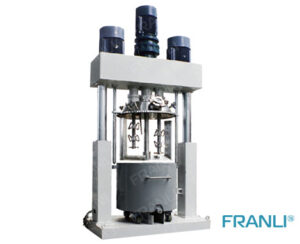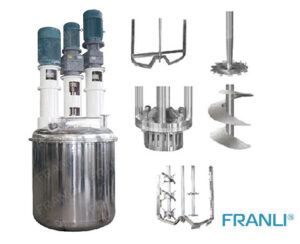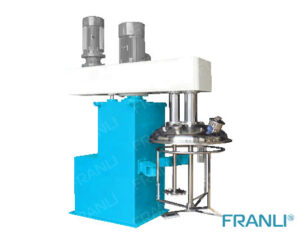Home » Multi-shaft mixer: Improving the production process of composite ceramics
Multi-shaft mixer: Improving the production process of composite ceramics
Multi Shaft Mixers
The field of ceramics has witnessed remarkable advancements in recent years, allowing for the production of high-performance materials with exceptional mechanical, thermal, and electrical properties. Among various ceramic processing techniques, the application of multi-shaft mixers has emerged as a promising method for the fabrication of composite ceramics.
Advantages of Multi-Shaft Mixer
- Which can mix the material ≤1,000,000 cps, stronger power, fully mixing high viscosity.
- The Teflon scrapper on the low speed (butterfly mixer), scraping the wall of the tank also bottom of the tank.
- The stainless steel round cover with vacuum system, to remove the foam and air, sight view glass, feeding system hole.
Application: Paint, Adhesive, Battery, Pharmaceutical industry, Cosmetic
Multi-shaft mixers, also known as multi-axis mixers, are versatile processing devices with multiple rotating shafts. They consist of two or more independently driven shafts with mixing elements attached at various positions along their length. These mixers provide controlled and efficient mixing by imparting complex flow patterns and shear forces on the material.
Composite ceramics are materials that combine two or more distinct ceramic phases to achieve unique combinations of properties. These composites are commonly employed in high-stress applications such as aerospace, automotive, and healthcare industries, where superior toughness, strength, and wear resistance are required. Fabricating these multi-phase materials with precise control over their composition and microstructure is essential for optimizing performance.
Homogenization of Ceramic Powders
In composite ceramics, achieving uniform dispersion and distribution of the different phases within the matrix is crucial for optimizing mechanical properties. Multi-shaft mixers play a vital role in homogenizing ceramic powders, ensuring an even and uniform mixture. The combination of different mixing elements, such as blades, paddles, and dispersers, on the multiple shafts facilitates efficient particle interactions, minimizing agglomeration and resulting in a well-dispersed powder mixture.
Controlled Particle Size Reduction
Particle size reduction is often necessary to improve the mixing of ceramic powders and to enhance the packing density of the resulting composite. Multi-shaft mixers can be equipped with shearing mechanisms, such as rotor-stator configurations or high-speed dispersers, which effectively reduce particle sizes. By employing these shearing forces, the mixers enable the creation of composite ceramics with enhanced interparticle contact area, leading to improved mechanical properties.
Mixing of Ceramic Slurries
Composite ceramics are frequently processed in the form of slurries consisting of ceramic powders dispersed in a liquid binder. Multi-shaft mixers excel in the preparation of these slurries, ensuring uniform distribution of particles in the liquid phase. The use of high shear mixing elements, such as homogenizers or cowles blades, promotes effective wetting and dispersion of the ceramic powders, resulting in a homogeneous slurry with high stability and reduced agglomeration.
Reinforcement Incorporation
Composite ceramics often involve the incorporation of reinforcing materials, such as fibers or nanoparticles, to enhance specific properties. Multi-shaft mixers facilitate the uniform dispersion of these reinforcements within the ceramic matrix. The combination of various mixing elements and a customizable configuration of the shafts enables the efficient integration of different reinforcement types, ensuring their optimal alignment and distribution.
Structural Integrity Enhancement
Achieving structural integrity in composite ceramics is imperative for their successful application. Multi-shaft mixers contribute significantly to enhancing structural integrity by facilitating the mixing of ceramic matrix materials with reinforcement materials, preserving the shape and alignment of reinforcing phases, and improving interfacial bonding. The resulting composite exhibits improved load-bearing capacity, crack resistance, and overall mechanical properties.
Scale-Up Considerations
In the realm of composite ceramics, multi-shaft mixers have emerged as integral tools for achieving material homogeneity and optimizing structural integrity. These versatile machines offer efficient mixing, dispersion, and particle size reduction capabilities, facilitating the production of high-performance composite ceramics with superior mechanical properties. By harnessing the potential of multi-shaft mixers, researchers and engineers can continue to drive advancements in the field of ceramic composites for diverse applications ranging from aerospace to healthcare industries.
In the context of leak-proofing agents, multi-shaft mixers have proven to be a game-changer in terms of efficiency, consistency, and versatility. Their ability to handle high-viscosity materials, enhance mixing capabilities, enable deaeration, and provide customization options makes them an ideal choice for manufacturers in various industries. By utilizing multi-shaft mixers, manufacturers can optimize the production process, resulting in leak-proofing agents that provide superior performance and reliability. As technology advances, these mixers will continue to play a vital role in the development of leak-proofing solutions, ensuring the integrity and durability of products in a wide range of applications.
Welcome to send inquiry to us and let’s make a win win business together !
Guidelines For Multi Shaft Mixer
FRANLI customized different kinds of multi-shaft mixers for more than 300+ customers. This kind of machine works in the coating industry, medicine industry, cosmetic industry, and other high technology chemical industries.

The Application of Triple Shaft Mixers in Adhesives
Triple-shaft mixers, also known as multi-shaft mixers, are innovative blending machines designed to efficiently mix and disperse various components in adhesives.

Triple Shaft Mixer: Ideal Equipment for Ink Production
Triple shaft mixers are capable of handling a wide range of ink formulations, including solvent-based, water-based, UV-curable, and hybrid inks.

The Versatility and Application of Triple Shaft Mixers in Coatings
Triple shaft mixers have revolutionized the coating industry by providing efficient and versatile solutions for mixing raw materials.

What is a Multi-Shaft Mixer?
A multi-shaft mixer is a type of industrial mixer that has more than one mixing shaft. These mixers are designed to mix multiple ingredients simultaneously, allowing for more efficient and effective mixing.

Dual Shaft Mixer – Dispersion & Stirring
The dual shaft mixer is the best mixer to dissolve the specific ingredients with appropriate shear capacity. This activity is performed by the high-speed shafts situated in the mixer and provides you with the perfect uniformity of the product. It also contains an Anchor agitator and a High-Speed Disperser that offer you the best quality and consistency.

Triple Shaft Mixer | anchor type, butterfly type & frame type
The FRANLI triple shaft mixer extends the working area by adding a rotating stator mixer with a large displacement or a second quick distributor. High shear stator and rotary mixer can emulsify and homogenize products that require higher shear forces to reduce particles into smaller sizes.

